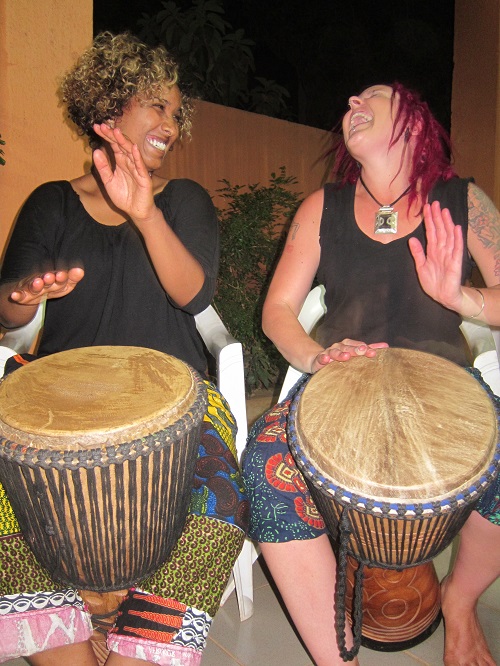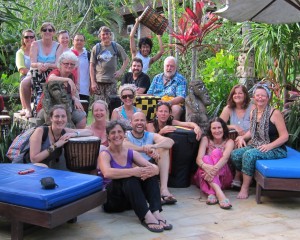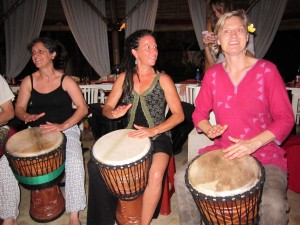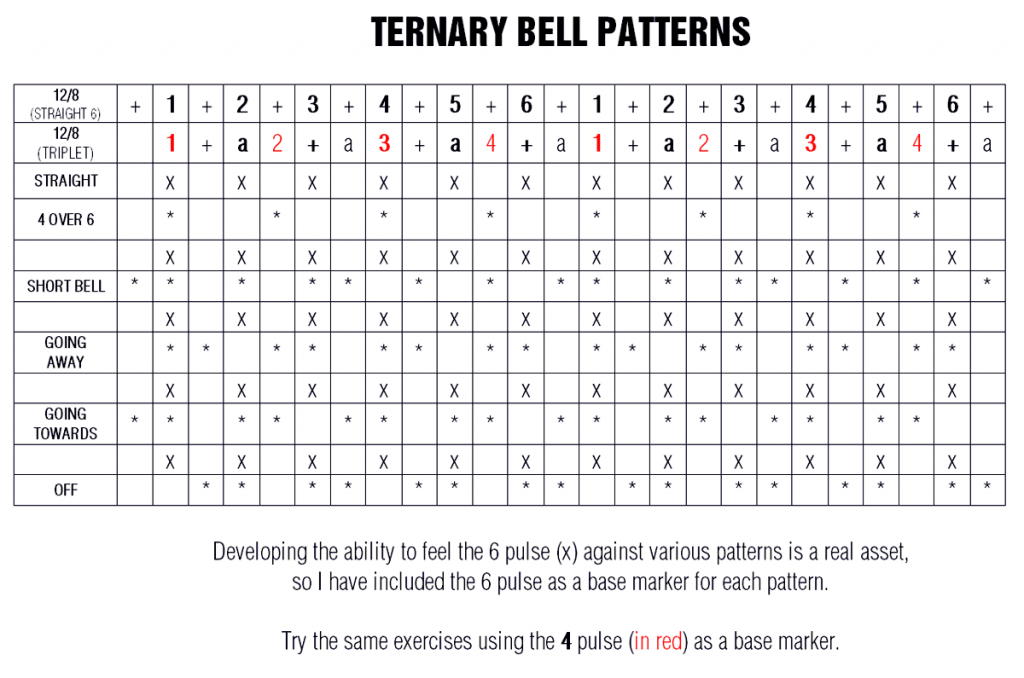Dexterity 101 – getting your right and left to work evenly and improving your non dominant side
Rhythm keeps beating for all of us while we breath.
Great article and nice to see our friend Tara Tucker doing more great work in Tasmania
ABC news article: African drumming offers all kinds of benefits to Hobart elderly residents
Another beautifully filmed and constructed clip that brings light to the ancient traditions of music and dance from the heart of West Africa
If you drum then you know how GREAT it feels!
It’s great to have far reaching evidence on how this music is healing and uplifting souls from all walks of life
We enjoyed this article:
http://www.greenmedinfo.com/blog/6-ways-drumming-heals-body-mind-and-soul
Just out now – the latest vNewsletter, with all the March news for African drumming, and a lightning tour of African Drumming HQ, care of JMan.
Our Bali Drum Camp is just 10 weeks away!
It’s not too late to book in and join us for 9 days of drumming in the lovely seaside village of Candidasa.
Tuza, Simon and guest teacher Tara are all looking forward to sharing the rhythms and insights into world of African Drumming ….
DRUMMING CLASSES IN WANGARATTA!!!
Happy to announce African Drumming is kicking off classes in Wangaratta this month
Venue: HP Barr Reserve Community Centre, Schilling Drive, Wangaratta
Day: Monday nights starting Monday 23/3
Time: 7:30pm (classes will run 7:30-9:00)
Your teacher is the wonderful Brianna Slattery who has been living further up the central coast in NSW for many years. Brianna is a qualified school teacher and African Drumming Certified L1/ 2 graduate … she has been playing Djembe for many years and is excited to connect with the local Wang and Beechworth drummers.
Top End Duns are hard to find … good quality hardwood dun shells are also hard to find, even when searching the Sahel in West Africa….
We always get excited when an extra special set hits the scene. Here’s an incredible set of hardwood duns from Burkina Faso. Made from Premium Heartwood Djala from Banfora Region.
The sound projection and quality is undeniable with these duns! Kenkenni really cuts through and the dun will play in to an ultra low bass.
Here’s a video of Simon playing on this incredible set.
Sessi Sessi is our energetic West African drumming community ensemble that’s made up with our advanced student group. Uplifting and high energy performances that gets the crowds moving are their specialty. Our talented students are lead by seasoned professionals who warmly welcomes everybody to dance and groove. Whether it be at a fund raiser, sports events, block parties, street festivals…..you name it: we’ll perform there!
Be part of the action and check out our Sessi Sessi facebook page
or
Download our Sessi Sessi Bio:
Here’s a video of Sessi Sessi playing in the background for October 2013 vNews Live from Flashjam
Rhythmic Challenge for the morning is another 12/8 bell pattern ( to continue the theme for this month.)
Get familiar with the “short bell” pattern on one hand (or wok or any other kitchenware you have handy!)
1 2 3 4 1
x . x . x x . x . x . x x
Now play away from the beat on your other hand.
1 2 3 4 1
x x . x x . x x . x x
You can see a diagram of the different bell patterns on last week’s blog entry, here!
It is tricky, but when you land it, it is so satisfying! Really does something to the pathways in your mind and body.
Something is growing internally and something is discovered, quite an exciting experience!
Hope to see you on Thursday 6:00pm – 8:00pm (and Saturday 10:00am-12:00pm) this week for four hours of rhythmic insight at Simon’s Dexterity Workshop. Dan will be supporting us all on dun as we go on a polyrhythmic journey into our bodies and minds to massage out the rhythmic gristle!

We have been working hard on our 12/8 bell patterns in the St Kilda Advanced class recently and it’s really coming together!
Using our feet to feel the 6 pulse and playing 5 different bell patterns over the top, then combining them all musically; there is something different about a polyrhythmic Agogo Bell orchestra!
One of the key foundation points is being able to feel the offbeat in our body whilst we walk the downbeat (pulse.) Harder than it sounds but over time our bodies relax into it, and two distinct pulses can be felt internally. Counting 1+2+3+4+5+6+ will help, and going SLOW to start is paramount. If we can feel these contrasting rhythms internally then we are much closer to being able to use them in our drumming. One can explore and execute more sophisticated timing structures and solos, wonderful huh?
Next challenge is to add some vocalisation (chant and song) to the mix; polyrhythmic fun and games with a musical twist!
Getting dexterous and ironing out the rhythmic gristle that binds up our bodies = more freedom for the body and mind.
If you want more, come and study dexterity with me next week!
– Simon.
For more information on Simon’s Dexterity classes, head here!
Trawling the internet, I came across these incredible photographs by Rita Willaert. Taken on her travels to West Africa, she stumbled upon a 1.2 hectare village near Tiébélé in Burkina Faso, made up of beautifully decorated mud brick homes, belonging to the Kassena people, one of the oldest ethnic groups who settled in Burkina Faso in the 15th century.
Video Series covering everything you need to know about tuning your djembe – for beginners.
Why should you buy from our Indo Series? Because they rock! No dodgy materials or rings set so high you can’t play. Just sweet djembes at sweet prices. Check out the A.D. difference: https://www.dropbox.com/s/elzaktjybldof1o/AD-Indo-Range.pdf
Get yours:
https://www.africandrumming.com.au/product-category/djembes-and-bougarabous/indo-series/
Drums made by drummers 🙂
Huffington – Unplugging from the daily rigors of life and recharging with music may be one of the most beneficial things to do for your body. Recent studies have shown that music may have a beneficial effect on your body’s immunity and overall health. This then gives your body a better chance to fight off disease and protect itself against the attacks of many illnesses. Below are some of the ways in which unplugging from stress and recharging with music may improve your life. But the ways in which music impacts your health may surprise you.
Full article: http://www.huffingtonpost.com/srinivasan-pillay/music-health-7-ways-in-wh_b_570038.html
BBC – Moving in time to a steady beat is closely linked to better language skills, a study suggests. People who performed better on rhythmic tests also showed enhanced neural responses to speech sounds. The researchers suggest that practising music could improve other skills, particularly reading.
Full article: http://www.bbc.co.uk/news/science-environment-24124158
From BBC
Moving in time to a steady beat is closely linked to better language skills, a study suggests.
People who performed better on rhythmic tests also showed enhanced neural responses to speech sounds.
The researchers suggest that practising music could improve other skills, particularly reading.
In the Journal of Neuroscience, the authors argue that rhythm is an integral part of language.
“We know that moving to a steady beat is a fundamental skill not only for music performance but one that has been linked to language skills,” said Nina Kraus, of the Auditory Neuroscience Laboratory at Northwestern University in Illinois.
More than 100 teenagers were asked to tap their fingers along to a beat. Their accuracy was measured by how closely their responses matched the timing of a metronome.
Next, in order to understand the biological basis of rhythmic ability, the team also measured the brainwaves of their participants with electrodes, a technique called electroencephalography. This was to observe the electrical activity in the brain in response to sound.
 Those with musical training had enhanced brain responses to speech sounds
Those with musical training had enhanced brain responses to speech soundsUsing this biological approach, the researchers found that those who had better musical training also had enhanced neural responses to speech sounds. In poorer readers this response was diminished.
‘Neural jitter’
“It turns out that kids who are poor readers have a lot of difficulty doing this motor task and following the beat. In both speech and music, rhythm provides a temporal map with signposts to the most likely locations of meaningful input,” Prof Kraus told BBC News.
The brainwaves recorded matched the soundwaves, she said. “You can even take the recorded brainwave and play it back through your speaker and it will sound like the soundwave.
“It seems that the same ingredients that are important for reading are strengthened with musical experience. Musicians have highly consistent auditory-neural responses.
“It may be that musical training – with its emphasis on rhythmic skills – can exercise the auditory-system, leading to less neural jitter and stronger sound-to-meaning associations that are so essential for learning to read,” added Prof Kraus
John Iversen of the University of California in San Diego studies how the brain processes music. He was not involved with the research but agreed that musical training could have important impacts on the brain.
“This study adds another piece to the puzzle in the emerging story suggesting that musical-rhythmic abilities are correlated with improved performance in non-music areas, particularly language,” he said.
From Easier Teamwork
PATTERN: The Foundation of Creative Freedom
We are what we repeatedly do. Excellence, then, is not an act, but a habit.
– Aristotle
Imagine something you’d like to do more consistently in your life — something that doesn’t take long, but uplifts your mood or energy, and makes a positive difference to the rest of your day. Perhaps it’s beginning each day with a little movement or meditation. Or maybe you want to escape from computer/chair-lock to move more often during the day. Perhaps it’s taking a head-clearing walk at lunchtime to get fresh energy and perspectives for a better afternoon.
These things are all simple, right? Our rational mind’s “cost-benefit analysis” say that these kinds of actions pay off for our health, happiness, and productivity. Yet if they were easy, a lot more of us would be flexible, fit meditators — or at least be seen upright and moving more often during the day! What can help us DO what we know is good for us?
Help from Everyday Rhythm: PATTERN
The Rhythm element of Pattern helps develop practices that anchor me in the groove of my desired life.
Pattern emerges from Pulse (rhythm’s steady foundation) and Cycle (groups of pulses moving forward in time). Pattern is made up of the notes that you actually play.
In other words, Pulse and Cycle form the structural framework of a rhythm, and Pattern is its audible manifestation.
Let’s take a basic 4-count cycle ◉ ◉ ◉ ◉
and create a pattern with words: “WA-ter-mel-on-GRAPES ● ● PEA ● ches-ba-NA ● na ●” Hear how it sounds in this 8-second clip.
Say that phrase out loud, and then play it on your lap or desk several times, like this. Let yourself get into it!
You’ve just created a rhythmic pattern that would fit into just about any drum circle song.
When the Mind Takes a Back Seat: From Challenge to Flow
The process of learning a new pattern on the drum offers a window into the formation of patterns in our lives. At first, our minds are involved, trying to “figure it out,” telling our hands what to do. This is the uncomfortable phase of trial and learning that often activates our inner critic. The antidote: Breathe and listen. Relax and try again.

Eventually, your mind learns that it can trust the hands and body to carry on with the pattern. This frees it to relaaaaaaaax, and simply notice the full experience of the moment. You sense your hands hitting the drum, the sounds you make, and the vibrations coming from others in the room.
At that point, your inner Observer can notice: What am I thinking, feeling, and wanting right now? Drumming becomes an active journey of mindfulness with that magic feeling of Flow.
Repetition Gets Results
In life, too, we adopt patterns that can perpetuate with little involvement from the mind. We call them Habits, and they are a powerful force for both accomplishment and misery in our lives.
On the positive side, thank goodness we don’t have to “figure out” each action or choice we make in daily life! How exhausted would we be if we had to consciously decide each step to get ready in the morning, drive to work, or perform the same task every day?
On the other hand, as we all know, habits can be just as strong when they’re not helpful, taking us further from our goals. Consciously shaping and cultivating habits is essential to successfully living to one’s chosen drumbeat.
Better Patterns = Better Life
Here is what Pattern and Rhythm have taught me about how to create positive habits in life:
Feel It In Your Why. Declare your commitment to the new habit by stating WHY you want to create it. Include both the result and the feeling you expect. For example, Why statements about creating a lunchtime walk habit might be: “I’ll feel energized, and open up to new ideas and insights by getting away from my desk.” “I’ll feel better physically, and be proud I did something good for my body.” “I’ll feel more connected to my co-workers and what goes on around here by getting out and walking around.”
- Imagine It, Beginning at the End. Give your new habit a head start with imagined practice. First, envision yourself enjoying the results and feelings after completing the actions of your new habit. Next, play your mental movie from the beginning, and imagine what triggers the routine. Then watch yourself take that first action, go through the steps, and enjoy the feelings at the end!
- Set Your Cue. Create a trigger to help yourself launch the new pattern. Set a reminder alarm, for example — preferably one you have to stand up and move to turn off. This is a critical moment in forming a new habit, where the voices of inertia serve up their excuses. (“Just let me send one more quick email.”) Don’t give in! Let your cue trigger your resolve as well as your action.
- Start Small. In drumming, we often learn new patterns by starting with just the first few notes. Then we add the others, one at a time, until the cycle is complete. Starting small works in creating new habits, too — with five minutes, for instance. Beginning a new habit like stretching, meditation, or a lunchtime walk with as little as five minutes makes a HUGE difference, compared to doing none at all.
- Tend the Transitions. There is usually a “tricky spot” in a drum pattern. That’s the place you’re most likely to “lose it,” to miss a note and fall out of the pattern. The same is true in establishing a new habit in life. The tricky spots are usually in the transitions — at the start, and when you’re bridging from one stage to the next. In our lunchtime walk example, the challenge might be walking past tempting conversations on your way to the door outside. Anticipate such transitions with relaxed focus. Don’t let a stumble pull you completely off track; simply take a breath, remember your Whys, and return to your pattern.
Pattern Brings Creative Confidence
Finally, enjoy being in the process of creating your positive habit! It’s not about “getting there” or doing it perfectly. It’s about being engaged in taking consistent, small steps in your desired direction — and appreciating yourself for it!

That’s what happens in a good jazz band, jam band, or drum circle. The players sink (and sync) into their patterns, which form a solid platform for something new and different to emerge on top — a burst of solo play, a new melody, a deliciously interweaving duet. Sweet!
Positive Patterns set the stage where Creativity can dance.
From Easier Teamwork
CYCLE: The Turning Wheel of Time
We began this blog series with Pulse, the foundation of Rhythm — and Life. But Pulse by itself — a repeating beat ● ● ● ● ● ● ● ● without any variation — gets boring pretty quick.
Pulse alone implies a steady state, a constancy. That makes it is important as our grounding anchor, the thing we can return to when we need to release the swirl of life’s details, and rediscover our center.
But Life moves forward. And so does Rhythm, with the introduction of Cycle.
Here is a representation of a 4-beat cycle:
◉ ● ● ● ◉ ● ● ● ◉ ● ● ● ◉ ● ● ●
Try playing it with alternating hands, on your lap or desk. ONE-two-three-four, ONE-two-three-four. Simply placing an emphasis on every 4th beat creates a repeating cycle. This should feel very familiar — think of your favorite rock song as you play.
Now try playing this — a 3-count cycle — also with alternating hands:
◉ ● ● ◉ ● ● ◉ ● ● ◉ ● ●
ONE-two-three, ONE-two-three, RIGHT-left-right, LEFT-right-left. It feels very different, doesn’t it? A 3-beat cycle has a “rolling” sense, compared with the back-and-forth of the 4-count. Even at their simplest, different rhythmic cycles create different feelings and moods.
Life Moves Forward in Cycles
In Life, as in Rhythm, time moves forward in cycles, with each initiation carrying forward from a new point in time. From the time our ancestral DNA began, we are profoundly rooted in Nature’s cycles, in our days and nights, our seasons and our years.
Yet the constant press of modern life, especially in the workplace, can often undermine or even trample, our sense of cycle. Push, push, push. Always striving for more, better, faster.
This is a recipe for burnout. Instead, if we tune into our cycles and work with them (rather than try to ignore them), we will more easily move into richer, more productive territory.
The Easy Way To Fall Back In

When this happens, simply pause, and take a breath. Listen to the complete cycle of the music, and hear where you want to come back in. Then, when you’re ready, listen as the rhythm cycle repeats, and “jump back on” when your recognized entry point comes back around.
In Life, it is also common to “fall off” of our natural rhythmic cycles from time to time throughout our day. “I feel out of sync,” we say, or, “I just can’t get into a rhythm with this task.”
We can react with frustration, and “try harder” to “catch up” to where we thought we “should be.” But this is like falling off of the merry-go-round, and chasing your empty spot around the circle to try to jump back on. It’s exhausting, and usually futile.
Instead, use the natural power of Cycle. Pause, take a breath, notice and let go of the “gotta – gotta – gotta” chatter in your head. Allow your own energy and attention to realign within yourself.

Let Cycle Bring You More Daily Ease
You can use the Rhythm Tool of Cycle to bring more ease and flow into your daily life. Here are a couple powerful ways:
Notice and ride your daily energy cycle. What time(s) of the day do you feel most alert? Most creative? Most physically energized? Where can you adjust your activities and work to align with your natural energy cycle? For example, if your most creative or high-focus time is late morning, protect it by minimizing meetings and interruptions during that time.
Create short work cycles within your day to “pump” your productivity. Here’s how:
- Choose the task you want to work on.
- Get clear and specific about exactly what the very next action step is.
- Set a timer for a finite amount of time of concentrated focus. Fifty minutes is a good maximum, especially if you’re sitting. If you’ve been fighting procrastination with this task, start with twenty minutes, or even ten. You can work on anything for just 10 minutes, right? That will feel MUCH better than putting it off, and you’ll often find it easy to keep going once you start.
- Breathe! As you start the timer, take a deep, refreshing breath, and wiggle your toes to reconnect your mind and body. Reaffirm your commitment to focus on ONLY THIS TASK for this next time period.
- Move. When the timer ends, say “Yay!” for your progress, and envision your specific next action steps. Then stand up and move around a little. If you are in a good flow, return to your work and keep going. Or, treat yourself to a short walk to get a drink of water, or spend a few minutes outside.

Cycles are powerful influences in our lives — forces to tune into and appreciate. They give us a sense of renewal, of starting fresh, of having another chance to change, or reach higher this time around.












 Feel It In Your Why. Declare your commitment to the new habit by stating WHY you want to create it. Include both the result and the feeling you expect. For example, Why statements about creating a lunchtime walk habit might be:
“I’ll feel energized, and open up to new ideas and insights by getting away from my desk.” “I’ll feel better physically, and be proud I did something good for my body.”
“I’ll feel more connected to my co-workers and what goes on around here by getting out and walking around.”
Feel It In Your Why. Declare your commitment to the new habit by stating WHY you want to create it. Include both the result and the feeling you expect. For example, Why statements about creating a lunchtime walk habit might be:
“I’ll feel energized, and open up to new ideas and insights by getting away from my desk.” “I’ll feel better physically, and be proud I did something good for my body.”
“I’ll feel more connected to my co-workers and what goes on around here by getting out and walking around.”

